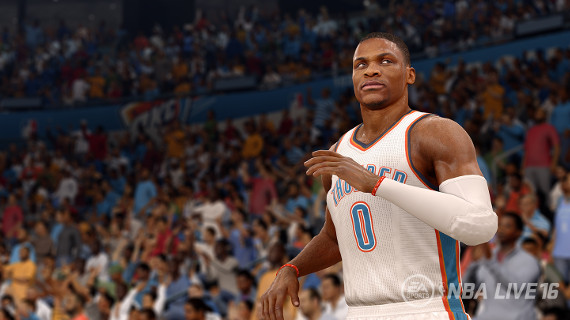Breaking down some of the NBA Live 16 footage out of E3

Yesterday the first breakdown of Madden NFL 16 footage was posted, taking a closer look at that game out of E3. Today attention turns to NBA Live 16 which EA Sports hopes will see a resurgence this year. The company is making some big claims that will draw additional scrutiny should they fail to live up to them but at this point they really have nothing to lose.
It’s important to be somewhat cautious in analyzing basketball games played by people, more so than other sports games, because poor or erratic play can make not only the user-controlled side look bad but the CPU as well. That being said here’s a look at the relevant plays from E3 footage for NBA Live 16 – what’s new, what looks good, and what still needs some work.
There’s a definite trend from EA Sports the past couple years in adding on-screen indicators that provide information to the user. Here you see it immediately with the jump ball. There’s even one that pops up for inbounding the ball with a five second countdown.
Here’s a nice feed from LeBron James to Timofey Mozgov on a pick-and-roll where both defenders stayed with LeBron. He probably could have led Mozgov with the pass out front rather than whip it behind the defender. Either way Mozgov should not have gathered himself in that manner, which gave the defense an opportunity to challenge the shot.
Stephen Curry is able to blow by Kryie Irving here for a nice floater in the lane. J.R. Smith chooses to cover Harrison Barnes who is settling outside the 3 point line rather than close on Curry. Mozgov was out of position, unwisely playing tight on Andrew Bogut 15 feet away from the hoop, leaving him unable to step into Curry’s path.
The CPU-controlled defenders botch this badly – Harrison Barnes and Klay Thompson both manage to get screened by Tristan Thompson. Good job by J.R. Smith going strong to the hoop with that opening.
This is a really natural looking play, a fluid handoff leading to Klay Thompson knocking down the jumper despite 29% on the timing. It’s great to see that the timing is only going to influence success, and not determine it. It’s unclear what the CPU defense was doing however with Timofey Mozgov initially out on the perimeter, but then switching with J.R. Smith who was down in the post. Smith doesn’t have a chance of making it out to cover Thompson in time.
Draymond Green knocks the ball loose from Tristan Thompson and picks up the ball for a fast break opportunity. He slows up however and it’s unclear if the user wasn’t using turbo or if the game just stuck Green in quicksand. The other concern on this play is LeBron, who’s in position to stop Green, but instead drifts away to cover another player. That left the lane wide open for an easy score had the user charged forward.
The user-controlled Curry reaches badly on a steal attempt, but the CPU Irving doesn’t take advantage as he casually walks the ball forward, allowing Curry to get back into position.
Even on free throws you’ll get the timing percentage displayed on-screen. This would seem more valuable, and easier to understand, than feedback like “slightly late or early”.
Unlike the earlier play, here CPU Kyrie Irving goes strong after the user takes Steph Curry out of position with an ill-advised steal attempt. You also get a good look at a new “defensive assignment line” which seems rather intrusive.
Steph Curry goes up and hits the underneath of the rim on this attempt, which seems unlikely to begin with, but especially since there was good “timing” on the shot. I’m not sure of the necessity of seeing that information for lay-ins or dunks anyway.
Here’s an example of where that “defensive assignment line” actually does some harm and could confuse novices. LeBron is heading in for a dunk on the fast break and Thompson, in the vicinity to make a play, has a line attached to someone who hasn’t even crossed mid-court. The CPU does a nice job of pushing the action here and exploiting poor transition D by the user.
Despite all the advancements being touted and some development time remaining, this early footage has shown arguably more to be discouraged by than one would have hoped to see, yet there’s reason for optimism as far as the modes go at least. The lack of content in Live 14 and 15 was almost as harmful to those products as the deficient gameplay. An online mode involving up to 10 players would help to disguise any AI issues as well. The GIFs used for this breakdown came from the following three videos: IGN – Sports Gamers Online – TDBarrett.
